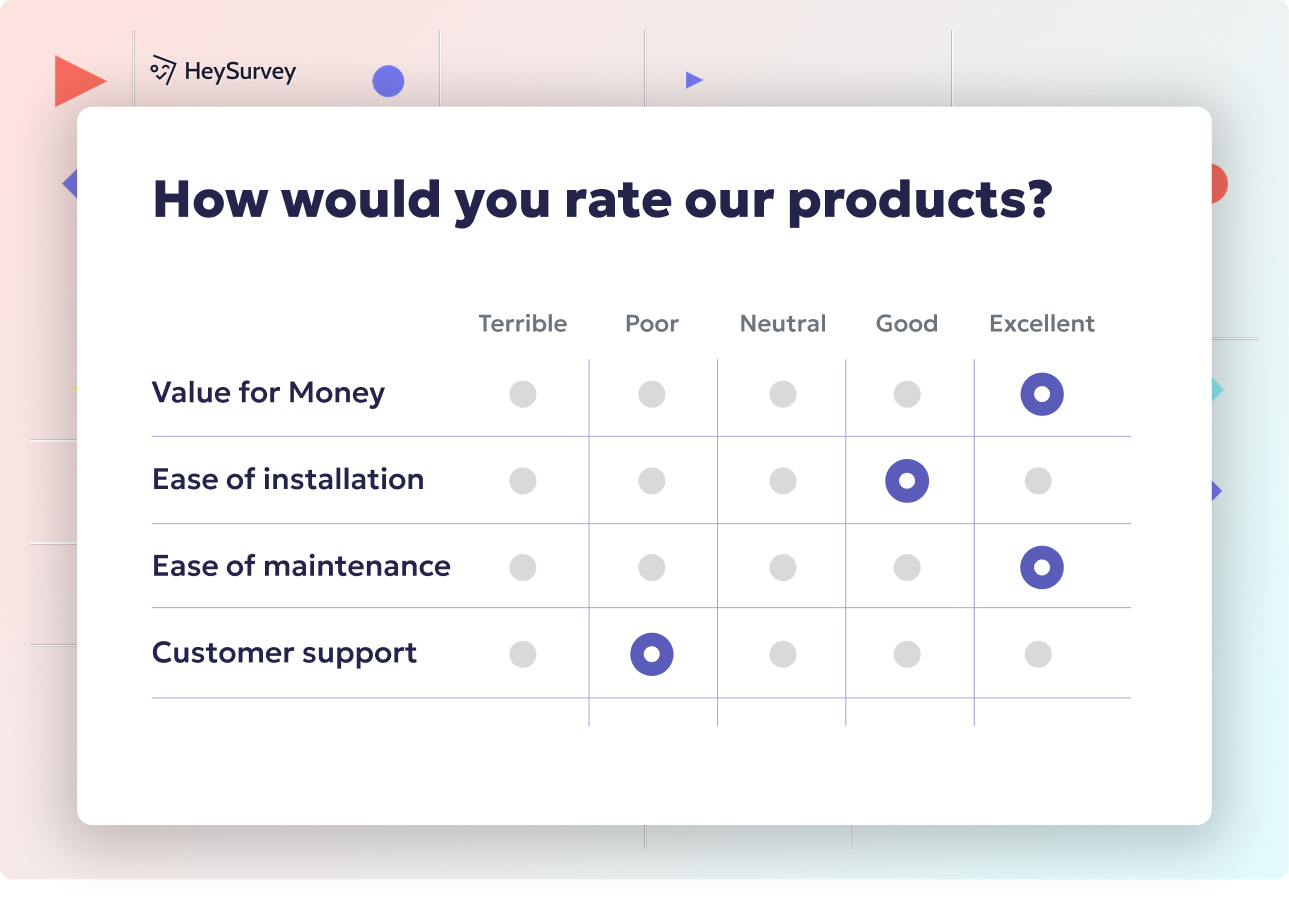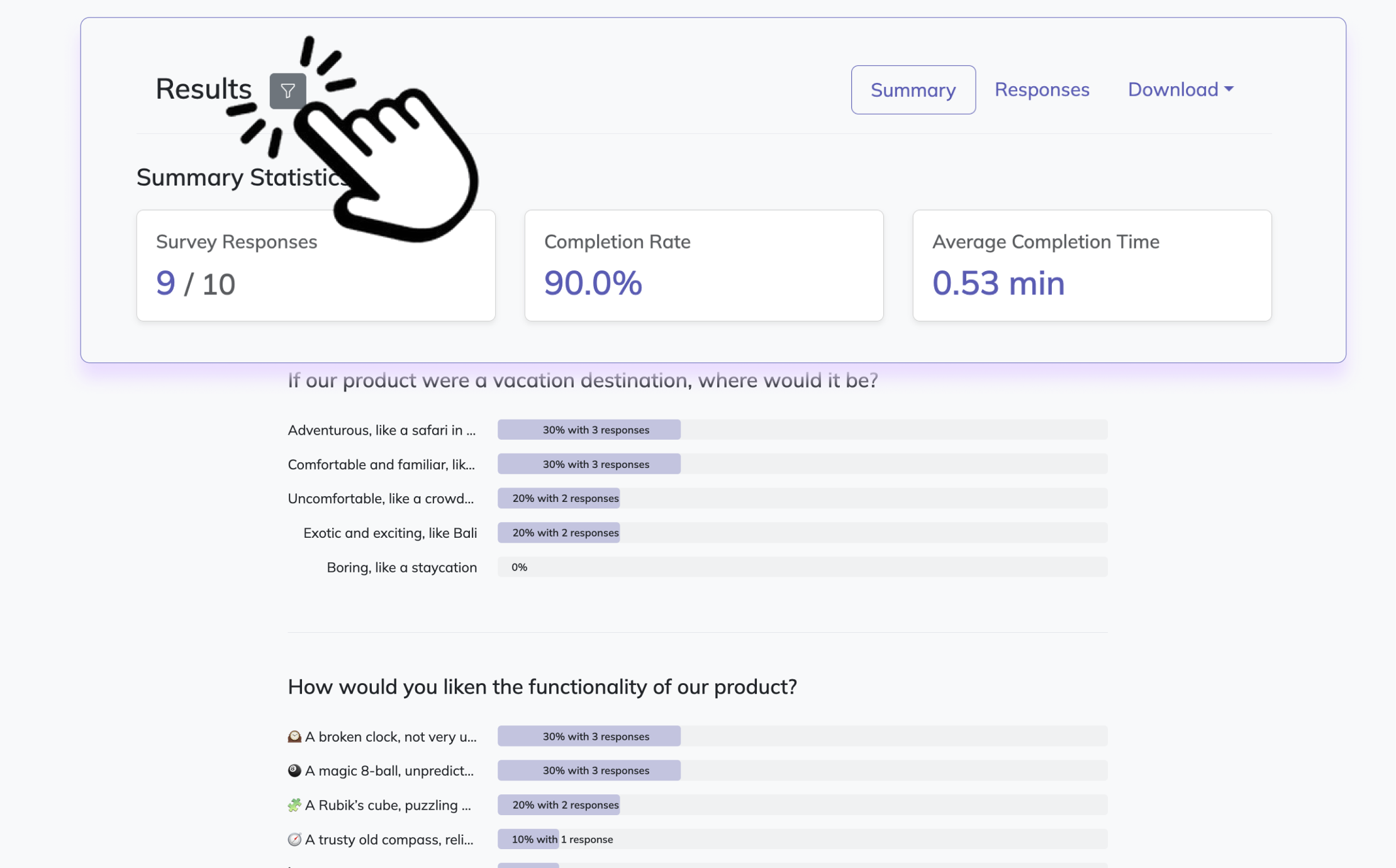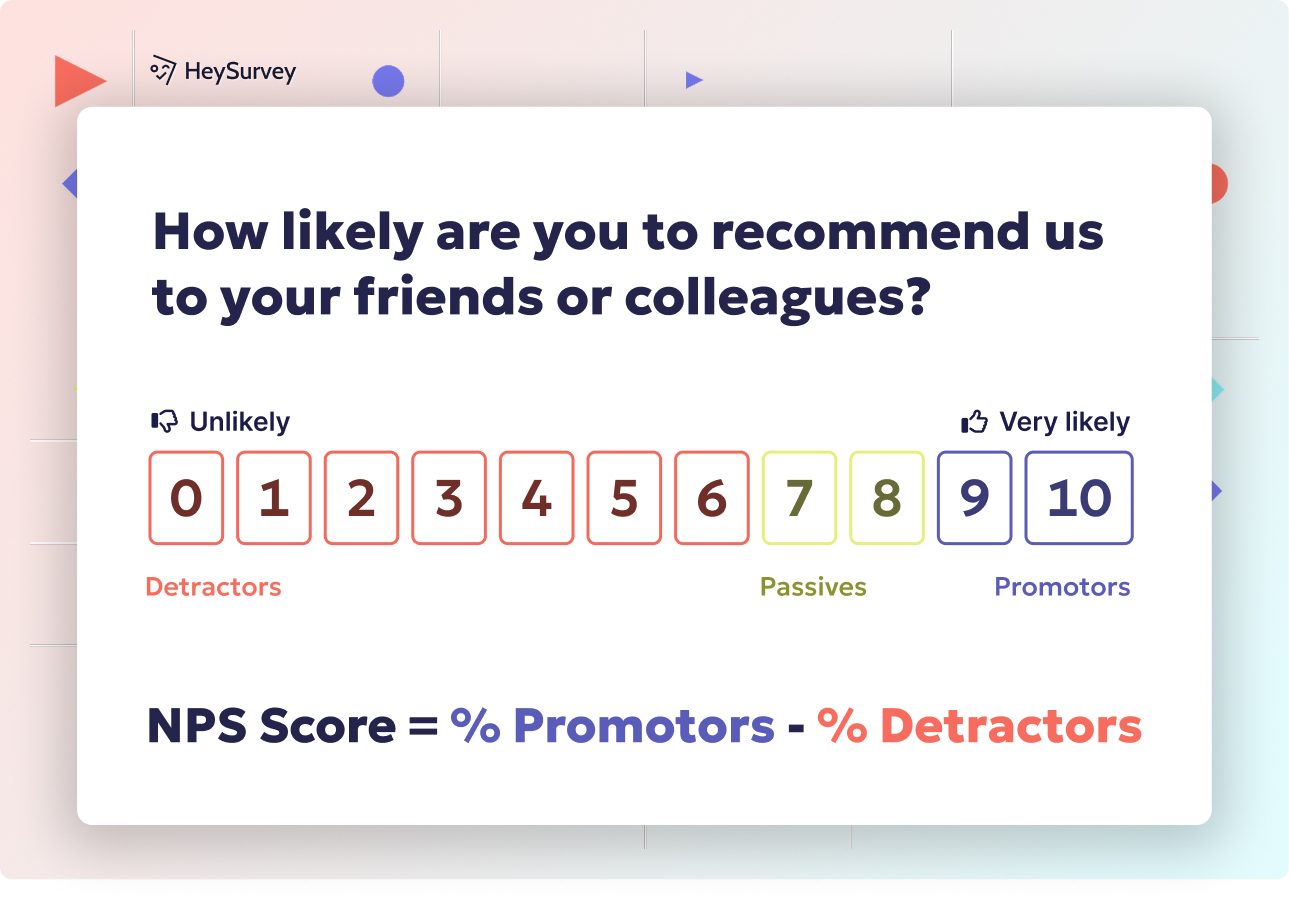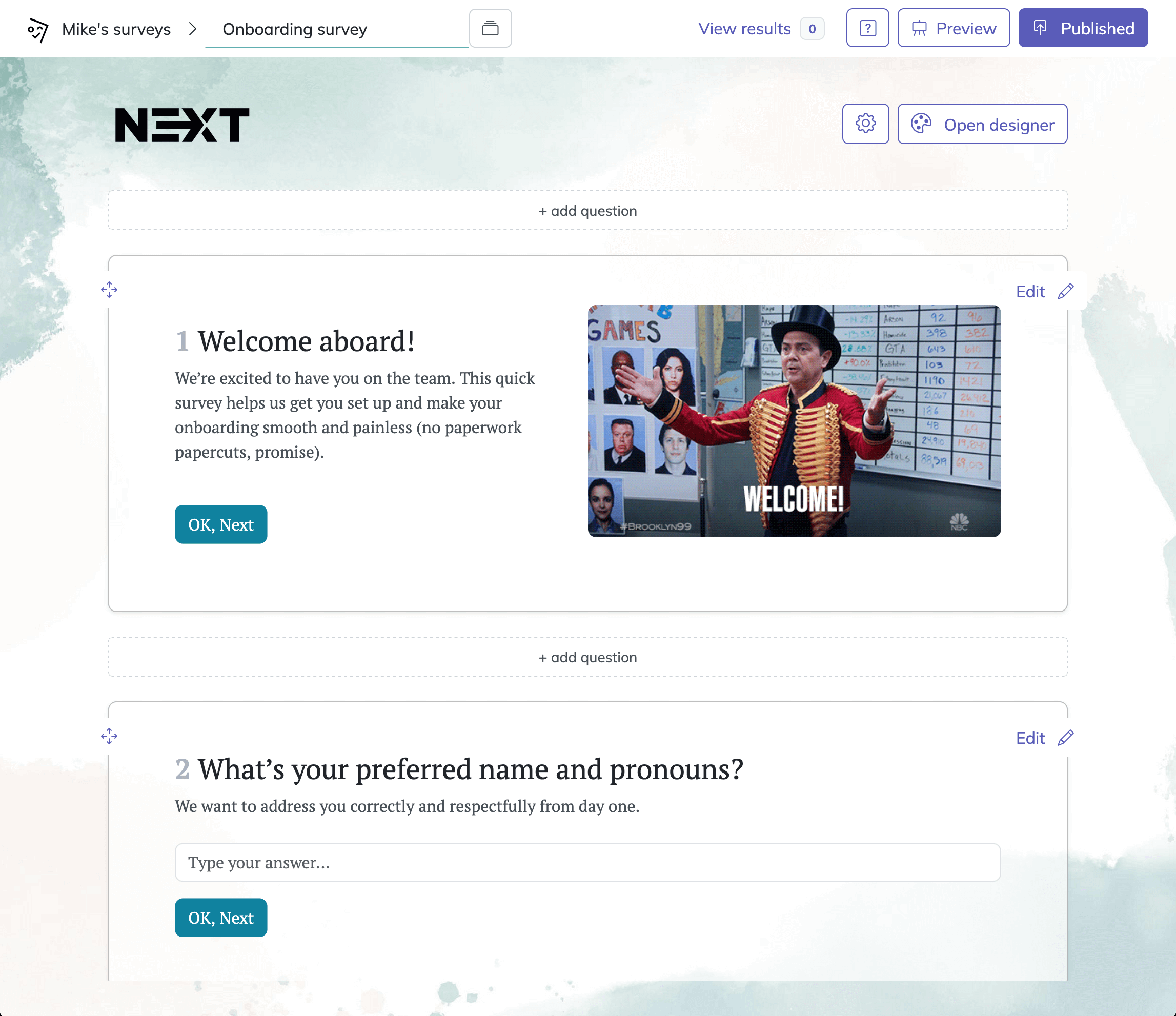31 Kindergarten Survey Questions for Parents, Kids & Staff
Discover over 25 insightful kindergarten survey questions for parents, kids, and teachers to boost engagement and improve early education programs.
Surveys have quietly become superheroes in the world of kindergarten. Whether you want to refine your curriculum, grow parent-teacher connections, or simply make the classroom a joyful space, asking for feedback unlocks doors. Stakeholders like parents, energetic kids, teachers, and administrators each bring a fresh perspective. Here, we’ll explore various kindergarten surveys, best times to send them, and packed examples that can spark real change using phrases like “kindergarten parent survey,” “child engagement questionnaire,” and “teacher feedback form.”
Parent Satisfaction Survey
Why & When to Use
Parent voices are your secret weapon for school growth. The kindergarten parent survey is not just about finding out whether parents are happy or not—it’s about discovering the how and why behind that satisfaction. These surveys reveal what’s working, what’s fuzzy, and what needs a total rethink.
Checking in with parents at key moments keeps everyone rowing in the same direction. Use a pulse check at mid-year to spot minor frustrations before they bloom into major headaches. Then, at the end of the school year, gather broader reflections on their family’s experience throughout the program. This process builds trust, and shows parents you’re listening.
Effective parent surveys focus on three things: satisfaction, communication, and potential improvements. These bite-sized checks help spot gaps and improvable processes—like outdated communication channels or overlooked family needs. When schools respond, parents feel valued.
Sending surveys digitally is convenient, but paper options still win over some families—never underestimate the power of a good old-fashioned printed form! Always allow some free response space for unique feedback, as it might surprise you.
5+ Sample Questions
How satisfied are you with the frequency and clarity of classroom updates you receive?
Does the kindergarten schedule meet your child’s needs throughout the week?
Rate your child’s emotional growth since starting the program.
How comfortable do you feel approaching the teacher about any concerns or questions?
What additional resources or activities would you like the school to offer for families?
Is there anything that could make the transition between home and school easier for your child?
How well do school events accommodate your family’s schedule and interests?
Parental satisfaction with early childhood education programs is significantly influenced by the emotional well-being of their children, the quality of collaboration with educators, and trust in schools and teachers. (researchgate.net)

How to Create Your Kindergarten Survey with HeySurvey in 3 Easy Steps
Creating your perfect kindergarten survey on HeySurvey is easier than tying your shoelaces! Follow these quick steps to get your feedback forms ready in no time.
Step 1: Create a New Survey
Head to HeySurvey and start by clicking Create Survey.
Choose whether to start from scratch with an Empty Sheet or pick a relevant Pre-built Template (we have handy kindergarten templates ready for you).
Give your survey a friendly internal name that helps you recognize it later (something like “Kindergarten Parent Satisfaction 2024”).
Once you’ve started, you’ll find yourself in the Survey Editor, the “command center” where all the magic happens.
Tip: You don’t even need an account to begin—just jump in! But to publish and collect responses, registering is a must.
Step 2: Add Your Questions
Click the Add Question button at the top or between any existing questions.
Choose the right question type for each prompt: Choice for multiple-choice or single answers, Scale for ratings, or Text for open-ended feedback.
Write your question clearly and keep it friendly.
For kid surveys, consider using images or smiley faces to make interaction fun and easy.
Mark must-answer questions as required to ensure you get the key info.
Don’t forget to explore advanced settings:
- Add an “Other” option for choice questions so respondents can add their own answers.
- Use branching if you want the survey to change based on a previous answer (e.g., different follow-ups for parents or teachers).
Preview your questions using the Preview button to see exactly how your survey will look and feel.
Step 3: Publish Your Survey
Once everything looks perfect, click Publish to make your survey live.
HeySurvey generates a shareable link you can send out by email, post on websites, or share on social media.
Remember, you must be logged in and have an account to publish and receive results.
Track responses in real-time on your HeySurvey dashboard.
Bonus Steps: Make It Truly Yours
Apply Your Branding
Upload your school or kindergarten’s logo to the survey header for a professional touch.
Open the Designer Sidebar to customize:
- Colors — match your school’s palette.
- Fonts — pick something playful or formal, depending on your style.
- Backgrounds — add a cheerful image or solid color for a warm welcome.
Define Survey Settings
Set your survey’s start and end dates to control when feedback is accepted.
Limit the number of responses, if needed.
Add a custom thank-you page or redirect URL after submission, sending families to your website or a helpful resource.
Choose whether respondents can view summary results post-completion.
Use Branching for a Personalized Experience
Dive into branching if you want to create different question paths:
- For example, a parent who answers “No” to being comfortable with communication might get a follow-up asking what would help.
- Teachers might be shown different resource questions than parents.
This keeps surveys short and relevant for each respondent group.
Ready to build your survey now? Simply click the button below to open a kindergarten survey template and start customizing with HeySurvey — easy as ABC!
Child Engagement Survey (Student Voice)
Why & When to Use
Little voices have big ideas—if you know how to listen! The child engagement questionnaire taps into the mind of every kindergartener. It’s the most delightful—and perhaps the most honest—feedback you’ll gather. These surveys help educators spot what’s fun and what’s “meh” in daily routines.
Because young children often express more with pictures than words, surveys should be visual and simple. Using smiley faces, thumbs up/down, or picture choices makes it easier for kids to share how they feel. These visual clues are gold for teachers adjusting activities on the fly.
Timing is everything for kid surveys! Collect input every quarter to notice ongoing trends. These mini check-ins show which activities are always a hit (or a miss) and help teachers freshen up routines before boredom creeps in.
Listen for the quiet “wishes” in the answers. Sometimes what a child doesn’t mention speaks just as loudly, revealing less obvious needs or dreams.
5+ Sample Questions
Which center (art, blocks, reading, or others) do you like to visit the most?
Do you enjoy story time or outdoor play more?
Point to the face that shows how you feel about snack time.
What is something new you learned this week that made you smile?
Is there an activity in class you wish we did more often?
Who do you like to play with most during free play?
Do you feel happy when arriving at school in the morning?
Kindergarten students exhibit higher engagement in literacy centers that incorporate production, social interaction, creativity, choice, and thoughtful use of technology. (digitalcommons.hamline.edu)
Teacher Feedback Survey
Why & When to Use
Teachers are on the frontlines—they see it all, every day. A teacher feedback form is where educators’ insights finally get heard and appreciated. Too often, teachers are the unsung heroes who can spot patterns before anyone else can.
Feedback from teachers should be collected both at semester breaks and at the year’s end. This timing lets leadership catch and fix pain points before they grow, and it also gives teachers a scheduled outlet for their thoughts. Anonymity is key—it ensures teachers can be candid without worry.
Topics might include everything from curriculum challenges to playground drama! When teachers share what’s working, what’s clunky, and what’s missing, administrators can respond quickly. This not only improves classrooms but also boosts teacher morale.
Consider making the survey quick to complete so that it feels like a conversation rather than a chore. Small actions based on teacher responses reinforce a “we’re in this together” atmosphere.
5+ Sample Questions
Which learning centers in your classroom require additional materials or support?
How effectively does the current professional development program support your teaching goals?
What behavioral trends or classroom challenges are you noticing that need more administrative support?
Rate the usability and helpfulness of lesson-planning tools provided by the school.
Suggest one change—big or small—that would boost instructional quality or student engagement.
Are there school-wide routines or policies you feel could be streamlined for teachers?
What additional training or resources would better support your teaching and classroom management?
Classroom Environment & Safety Survey
Why & When to Use
A sparkling classroom and a safe playground are the heartbeat of stress-free learning. The classroom environment and safety survey gives everyone a voice on these important basics. It’s more than fire drills and locked doors—it’s about emotional safety too.
Deploy this survey after big changes—like facility upgrades or new safety policies. Parents, staff, and even older students can highlight what’s going well or what’s lagging behind. When collected after a renovation or new health policy, the feedback has immediate relevance.
Ask about everything from cleanliness and air quality to comfort with emergency procedures. Parents especially need to know their children are in a secure, cared-for place. Teachers will notice if materials are stored too high or if allergy protocols are tricky to follow.
Encourage all voices, even if improvements take time. Sometimes small fixes—like a new classroom carpet or staggered drop-off—make the biggest difference in perceived safety and comfort.
5+ Sample Questions
How secure do you feel the arrival and pickup process is at this school?
Are classroom materials and learning centers organized and accessible for all children?
How well does the school address allergy concerns or specific health needs?
Rate the cleanliness and upkeep of shared spaces, such as bathrooms and cafeteria.
What safety improvements or changes would you prioritize for the school?
Do you feel children are supervised adequately during free play or outdoor time?
Are emergency procedures well communicated to families and staff?
A study found that preschool educators emphasize the importance of a learning environment that is emotionally and physically safe, age-appropriate, resourceful, with clear rules, and predictable routines. (ecrp.illinois.edu)
Program Evaluation & Curriculum Survey
Why & When to Use
A strong program review is the secret sauce for steady school progress. The program evaluation and curriculum survey checks how well your learning plan matches up to those big early childhood goals. Are you nurturing little readers, budding scientists, and future leaders?
Year-end is perfect for curriculum feedback. It helps you identify the shining stars and the dull spots—topics or activities kids loved, and areas that felt lackluster. Right before accreditation reviews is another great timing, as you gather hard data on how the curriculum meets standards.
Evaluating the curriculum together with staff, families, and (when possible) students reveals surprising connections. Some units might need sprucing up with more diversity, or maybe that new science corner deserves more time. Use what you learn to build next year even stronger.
Gather open-ended suggestions so everyone’s ideas are heard. It’s these comments that spark innovation and creativity.
5+ Sample Questions
How well does the kindergarten curriculum foster early literacy and language skills?
Which thematic units or projects were most engaging and memorable for children this year?
Does the program provide enough cultural diversity and inclusion in its learning materials?
How effective are science, technology, engineering, and math (STEM) activities in sparking curiosity among students?
What content areas (e.g., art, physical education, music) do you feel are underrepresented or need more emphasis?
Are learning objectives clearly communicated to families throughout the year?
What suggestions do you have for making the curriculum even more relevant and engaging for your child?
Kindergarten Readiness & Transition Survey (Pre-K to K)
Why & When to Use
That leap from “little kid” to “kindergartener” is a milestone worth celebrating—and planning for! The kindergarten readiness and transition survey is designed for families about to join the program. It helps schools smooth those first-day jitters with data-backed insights.
Deploy this survey in late spring or early summer to inform orientation and welcome events. Incoming families share their child’s strengths, areas of nervousness, and past preschool experiences. By knowing these details, schools can tailor their approach and ease anxieties for kids and parents alike.
Surveying new families not only preps teachers but also forges early bonds with parents. When families feel seen at the very beginning, trust grows naturally. Plus, you’ll catch early needs for extra language support, separation anxiety, or particular skill-building.
Keep surveys short, friendly, and encouraging, so parents don’t feel pressured and share honestly about their child’s unique path so far.
5+ Sample Questions
How confident is your child in recognizing and naming letters and numbers?
What is your biggest concern or hope regarding your child’s transition to kindergarten?
Has your child attended any preschool or early childhood program prior to this?
Does your child separate easily from caregivers at drop-off, or is this an area for support?
Which specific skills (e.g., fine motor, social, language) would you like the kindergarten to focus on first?
Are there any family traditions, languages, or holidays you wish to see reflected in the classroom?
What information would help your family feel more prepared for the first day of school?
Best Practices, Dos & Don’ts for Kindergarten Surveys
Surveys are only as good as the questions you ask and the way you ask them. Make every question count by trimming jargon and sticking with plain, friendly language. Busy parents and teachers appreciate quick, clear forms that don’t add to their day’s stress.
Balance your format: use simple scales and open-ended questions. This mix lets you gather easy-to-analyze data plus those magical “aha!” comments. Let kids respond with smileys or choose icons—it’s way more fun (and insightful) than a yes/no checklist.
Don’t overdo it. Limit surveys to 10–15 questions to avoid eye rolls. And always remind everyone that their feedback is confidential. When people see changes happen based on their opinions, they’ll want to participate again.
Here’s a winning formula for survey success:
Do keep all language short, conversational, and easy for all levels of English speakers.
Do invite both quantitative (rates, scales) and qualitative (comments, suggestions) feedback.
Don’t try to squeeze too many questions into one form—focus on quality over quantity.
Do use smiley faces, tick boxes, and illustrations, especially for young children’s questionnaires.
Don’t forget to close the loop: thank participants, share what you learned, and update them on improvements.
Making feedback easy and rewarding is the key to long-term school improvement.
Conclusion & Next Steps
Kindergarten surveys turn everyday opinions into a bright spotlight for growth. By asking parents, kids, and staff for input regularly, you unlock a 360-degree feedback loop that drives joyful classrooms and connected communities. Mix and match from the question banks above, try new digital survey tools, and reflect often to stay ahead of needs. Explore our free template pack to jumpstart your surveys and subscribe for more powerful early-education tips!
Related Feedback Survey Surveys

25 Catering Survey Questions to Collect Actionable Feedback
Discover 30 expert catering survey questions to gather actionable feedback that enhances menus, s...

30 User Feedback Survey Questions for Better Insights
Discover 40+ user feedback survey questions across 8 types to boost product insights, UX, and cus...

30 Environment Survey Questions to Measure Eco Awareness
Discover 25 sample environment survey questions to effectively assess attitudes, behaviors, and c...

